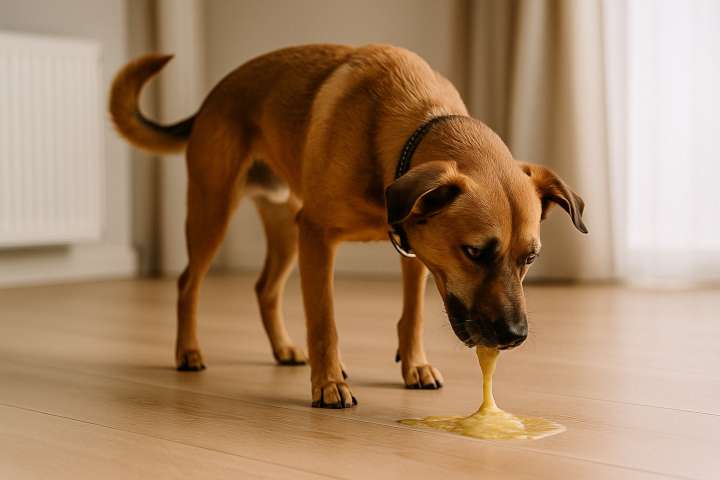Why is my dog vomiting? It’s a question no pet owner wants to ask—but knowing the possible causes can help you respond appropriately. Seeing your dog vomit can be alarming, but not every case is an emergency. Dogs may vomit due to something mild and temporary, like eating too fast, or due to serious health issues that require immediate veterinary care.
In this guide, you’ll learn the most common reasons why dogs vomit, how to tell when it’s serious, and what you should (and shouldn’t) do when it happens.
What Does Vomiting in Dogs Look Like?
Vomiting is the forceful ejection of stomach contents through the mouth. It’s different from regurgitation, which is passive and usually happens shortly after eating.
You may see:
- Food, bile, foam, or yellow/green liquid
- Retching or heaving beforehand
- Signs of nausea: licking lips, drooling, pacing
Common Causes of Vomiting in Dogs
Mild or Temporary Causes:
- Eating too fast
- Diet change or new treats
- Motion sickness
- Grass ingestion
- Minor stomach upset from table scraps or spoiled food
- Parasites (in puppies especially)
These may resolve on their own with rest and fasting.
More Serious Causes:
- Toxins or poisoning (chocolate, grapes, medications, cleaning products)
- Pancreatitis (often from fatty foods)
- Gastrointestinal obstruction (from swallowed objects like toys or bones)
- Kidney or liver disease
- Infections (viral or bacterial)
- Food intolerances or allergies
- Bloat (gastric torsion) – a true emergency
- Cancer or tumors
- Chronic conditions like inflammatory bowel disease (IBD)
When to Call the Vet Immediately
Seek urgent veterinary care if your dog:
- Vomits multiple times in one day
- Has bloody vomit or vomits something that looks like coffee grounds
- Shows signs of lethargy, weakness, or collapse
- Is also having diarrhea, fever, or abdominal pain
- Has a bloated or hard abdomen
- Is a puppy, senior, or has existing health issues
- Has been vomiting for more than 24 hours
Early treatment can prevent dehydration and detect life-threatening issues.
What Will the Vet Do?
Depending on symptoms, your vet may recommend:
- Physical exam and checking hydration levels
- Blood tests to check for organ issues or infection
- X-rays or ultrasound to look for blockages or tumors
- Stool exam for parasites
- IV fluids for hydration
- Medications to control nausea and protect the stomach
If a foreign object is the cause, surgery or endoscopy may be required.
What to Do at Home (for Mild Cases Only)
If your dog is otherwise healthy and vomits once or twice, try this approach:
1. Withhold Food for 12–24 Hours
- Give the stomach time to rest
- Ensure access to clean water in small amounts
2. Introduce a Bland Diet
After fasting, feed small portions of:
- Boiled chicken (no skin, no seasoning)
- Plain white rice or pumpkin
- Feed 2–3 small meals per day for 2–3 days
- Slowly reintroduce regular food over 3–5 days
3. Avoid Treats, Chews, and Fatty Foods
Stick to simple, easily digestible meals during recovery.
Preventing Future Vomiting
- Avoid feeding table scraps or fatty foods
- Don’t allow access to trash, houseplants, or toxic substances
- Keep toys and small items out of reach
- Use a slow-feeder bowl if your dog eats too quickly
- Transition foods gradually over 7–10 days
- Deworm regularly and stay up-to-date on vaccines
Conclusion
Final Thoughts on Why Is My Dog Vomiting
Occasional vomiting isn’t always a cause for panic—but frequent or severe vomiting is never normal. Knowing the signs, acting quickly, and speaking with your vet when needed can protect your dog from serious illness.
Want a printable Vomiting Tracker or Emergency Vet Checklist? Visit our Dog Health Symptoms Hub for free tools and care guides.

